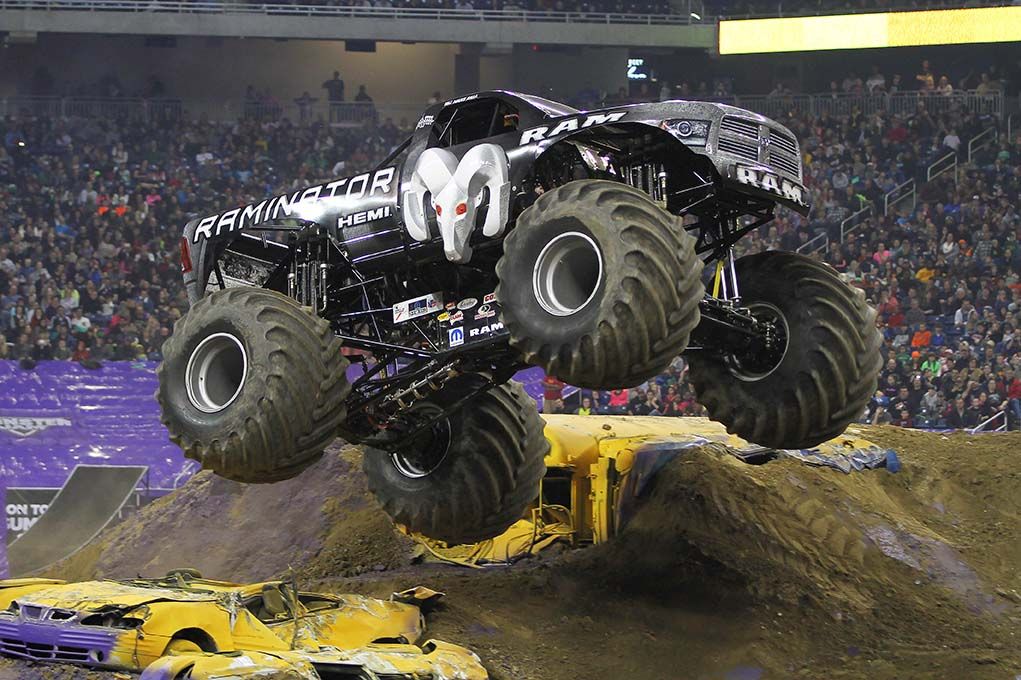Typical monster truck tires
One of the most recognizable features of a monster truck are its large tires. Monster trucks use tires originally created for agricultural equipment, modified for use on monster trucks, with some tires being specifically made for monster trucks. Standard modern monster truck tires are 66 inches tall and 43 inches wide.
With the growing popularity of mud bogging in the 1970's, there began a quest to find larger, more suitable tires for increasing a 4-wheel drive pickup truck's capabilities in the mud. Early on, 48 inch agricultural tires were the standard for the few monster trucks that did exist, such as Bigfoot and King Kong, specifically the iconic design of the Goodyear Super Terra Grip tires.
These tires are also known as flotation tires, as they were originally designed so that their volume of air means the farming equipment that uses them can float slightly on wet, muddy fields instead of sinking into the mud and getting stuck.
In 1979, a vehicle known as "Mud Rat" was seen at a mud bogging event sporting a set of 66x43-25 inch Super Terra Grip tires, which caught the attention of various monster truck owners, giving them the inspiration to put them on their trucks as well. On September 1st, 1982, Bigfoot 2 would make its first public appearance with a set of 66 inch Terra tires, leading others to follow suit.
An example of just how far the tires flex for just a split second
One tire alone, without the rim, can weigh anywhere from 800-900lbs; when multiplied by four, tires take up about a third of the truck's average 10,000lb weight. A team can go through as many as eight tires in a single year. Tires can cost $2500-$7500 each.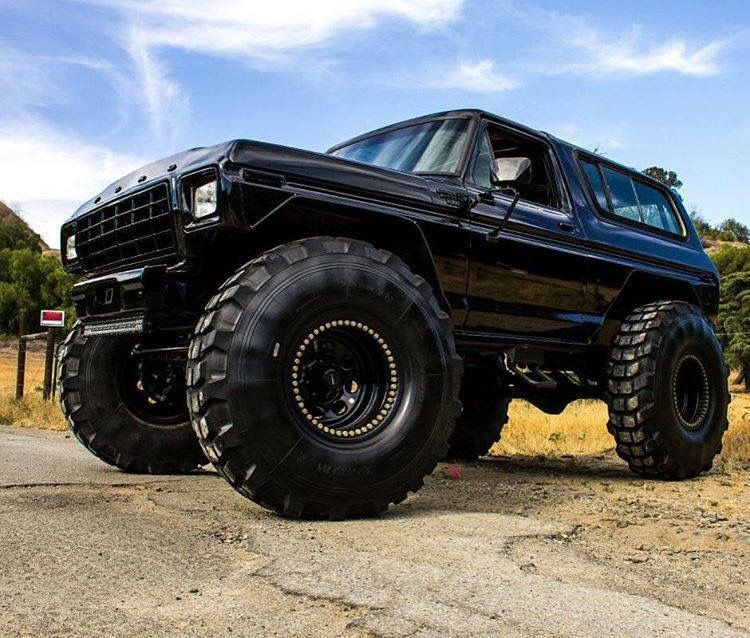 Despite their size and rigidity, due to the weight of the trucks the tires tend to flex a considerable amount. This generally occurs only for a split second, but sometimes the tires flex so much that the rims of the wheels make contact with the ground. To combat this, some drivers over-inflate the tires. This, however, raises the risk of tire blowouts.
Despite their size and rigidity, due to the weight of the trucks the tires tend to flex a considerable amount. This generally occurs only for a split second, but sometimes the tires flex so much that the rims of the wheels make contact with the ground. To combat this, some drivers over-inflate the tires. This, however, raises the risk of tire blowouts.
A finely cut tire
One of the most distinct elements of a monster truck tire is the tread pattern of the tire. The agricultural tires that are the basis of monster truck tires usually have a simple tread of deep, sharp V-shaped or alternating stripes (depending on manufacturer) intended to provide grip in mud or loose soil without getting clogged with earth. For monster truck use, this tread is modified by the team, usually by removal of some rubber through "cutting". Tire cutting is done though for more than just stylistic reasons, though, as different tire treads result in different performance.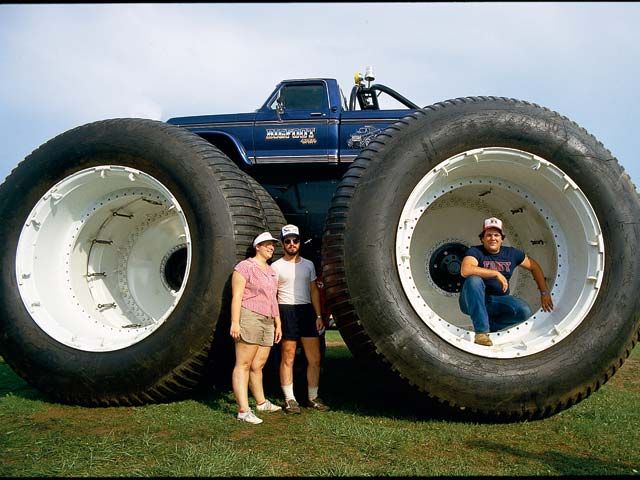 Tire cutting is also done to accommodate the driver's driving skills and the conditions in which the truck will be driven. The most common modification made is to reduce the overall tread depth, which reduces weight and increases flexibility, and to round the edge of the tread near the sidewall, which makes it easier for drivers to upright the truck if they land on the edge of the tire after a jump. Cutting each individual tire takes approximately 50 consecutive hours.
Tire cutting is also done to accommodate the driver's driving skills and the conditions in which the truck will be driven. The most common modification made is to reduce the overall tread depth, which reduces weight and increases flexibility, and to round the edge of the tread near the sidewall, which makes it easier for drivers to upright the truck if they land on the edge of the tire after a jump. Cutting each individual tire takes approximately 50 consecutive hours.
Obsessed runs its tires backwards.
A majority of trucks have their tires mounted with the tire stripes pointing downwards. On occasion, trucks may run some, or all tires facing the opposite direction. This may be for stylistic reasons, or because the backwards facing tire is an opposite side replacement for a flat.
Tire types
There are plenty of tire designs and almost all trucks used a familiar ‘V’ tread pattern. It helps the truck maintain grip on dirt surfaces and even in mud races.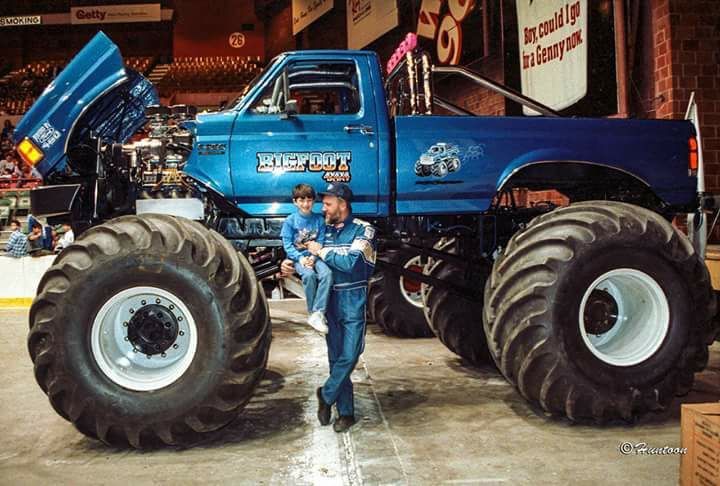 There are some unique tread patterns that some trucks use for style.
There are some unique tread patterns that some trucks use for style.
• Common ‘V’ Tread: a tire that has a slanted ‘V’ tread that overlaps one another slightly. MOST trucks in shows, particularly Monster Jam would use these tires made by BKT.
• Hybrid Tread: this tire has a unique light V Tread that trucks would use for racing. These tires were seen and used on many trucks such as Bounty Hunter. These types are lesser known and are still used to this day.
• Half Striped: these tires as lesser known and were used on the monster trucks Predator, Prowler, and Pouncer. The treads are unique and they have more of spiked style edges to the tire to help the truck gain grip while turning tightly. These tires were originally made by Goodyear before they were discontinued.
• Plain: tires that have NO tread, or have little grooves within. These tires are used on concrete surfaces or used on ride trucks. These tires are RARELY used on any competition trucks, but these tires HAVE been used before in trucks such as Prowler, Pouncer, Predator, and Avenger.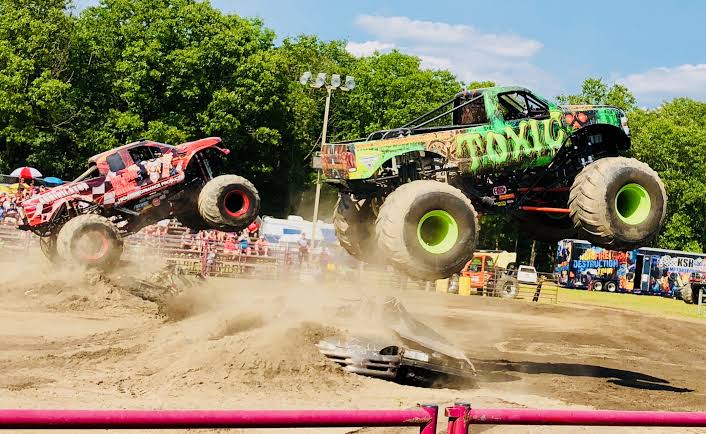
Bigfoot having been unloaded from its trailer.
Monster truck tires are so large with their regular tires that they cannot fit into their transportation trailers. Because of this, the tires have to be mounted on and unmounted back off after every show weekend. Much smaller tires, taken from the ones used for irrigation equipment, are put onto the truck so it can be driven back into its trailer. These are used as they can match the hubs on the large tires. Trailers have doors on the side that allow for the tires to go in and out easily when loading and unloading the truck.
The most notable non-standard tire used are ten-foot tires: First used for monster trucks on Bigfoot 5, these were originally created for use on a US Army "land train" in Alaska. "Plain" tires are used mostly on ride trucks, and rarely on race trucks. The most notable exception was when Predator trucks exclusively used these tires in the early 2000's.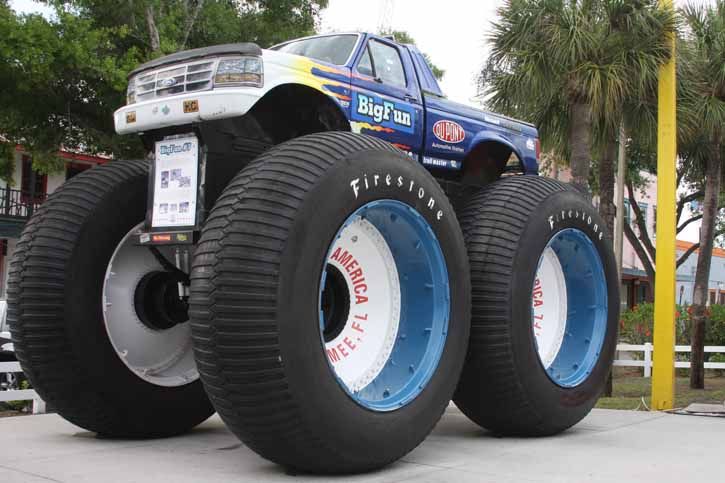
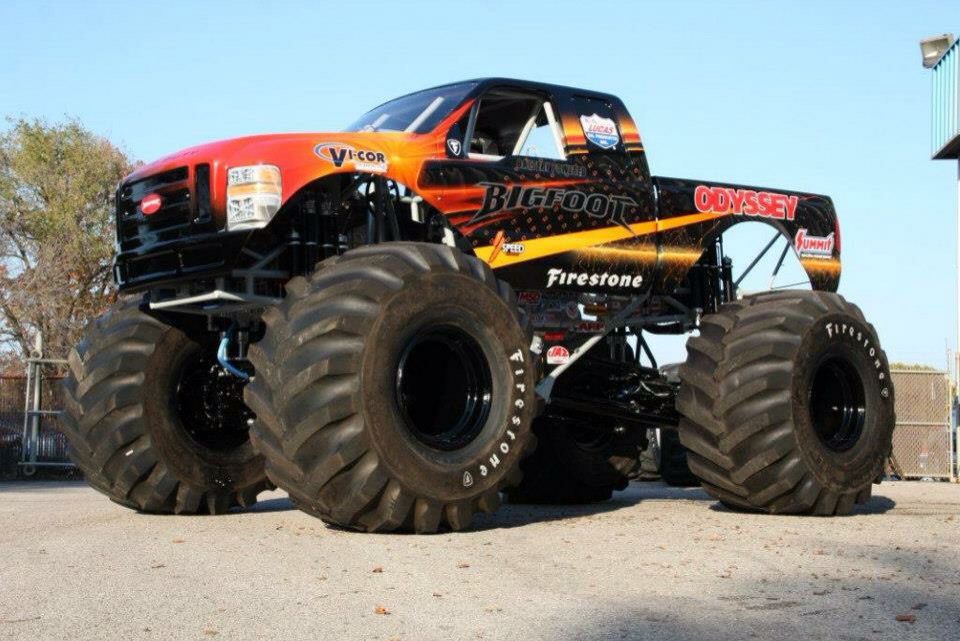
Raging Bull loses a tire in 2015 that hit 9 people. Thankfully, nobody was killed.
Trucks can often times lose tires from hard hits, causing them to roll away over great distances.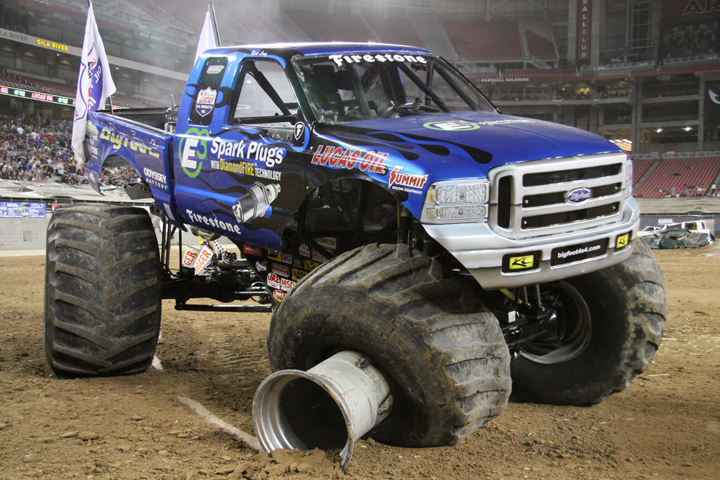 The large weight of the tire can pose a safety risk when this happens. In 2012, when Marc McDonald, driving El Toro Loco in Arlington Texas, lost a tire during freestyle, it bounced several times, initially in excess of 20+ feet high. It collided with the Fiesta truck and landed wedged between the truck and the wall; thankfully, nobody was hit by the tire. That was the second time that night a truck had lost a tire, a nearly similar incident happened with Bounty Hunter during that same show.
The large weight of the tire can pose a safety risk when this happens. In 2012, when Marc McDonald, driving El Toro Loco in Arlington Texas, lost a tire during freestyle, it bounced several times, initially in excess of 20+ feet high. It collided with the Fiesta truck and landed wedged between the truck and the wall; thankfully, nobody was hit by the tire. That was the second time that night a truck had lost a tire, a nearly similar incident happened with Bounty Hunter during that same show.
In 2015, Raging Bull lost a tire at a monster truck show and caused it to roll into a fence next to a section of spectators. The tire crashed into the fence and injured nine spectators on the other side; thankfully, nobody was killed.
In 1998, a fire burned down a garage resulting in Demon, Kimosabe, Showtime, and the Weapon 1 Ride Trucks all being destroyed. The fire was caused by tires that caught fire due to a faulty battery on a "power wheels" vehicle. The tires expanded from the heat until they violently burst, resulting in further explosions and causing the destruction of the garage.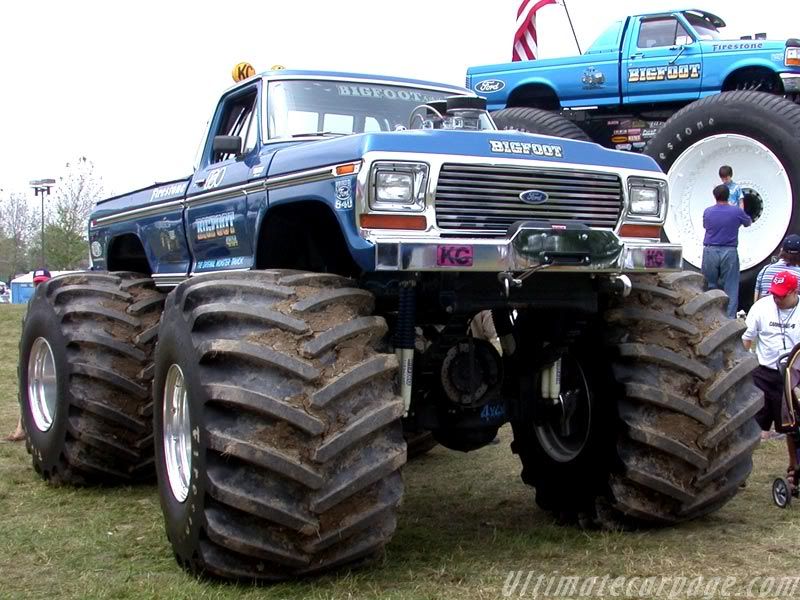
Gas Monkey Monster Truck Tire Installation - Monster Jam
Video of tires being mounted on Gas Monkey Garage
Regular tires.
A chunkier, more rigid tire cut.
Tires with slanted lugs.
Firestone tire.
El Toro Loco's "Hybrid" tires.
Brute Force with "fine cut" tires.
Predator's "Half striped" tires.
Grave Digger 11 running "plain" tires.
Pouncer with two front "plain" tires, one of the very few times they have ever been used on a racing truck. Also, the back tires are backwards.
Dale Earnhardt, Jr. with "checkered" tires.
Two variants of the Scaly tire on Storm Damage.
Gangsta, with 'overlapping" tires.
The Red Ford Grave Digger with tractor tires.
5 Ton Turd with smaller, mud bogging tires.
Bigfoot 5 with its notable 10 foot-tall tires.
Superfoot with a different variation of the 10-foot tires.
Grave Digger's brand new BKT tires with purple beadlocks.
A tire shop full of monster truck tires.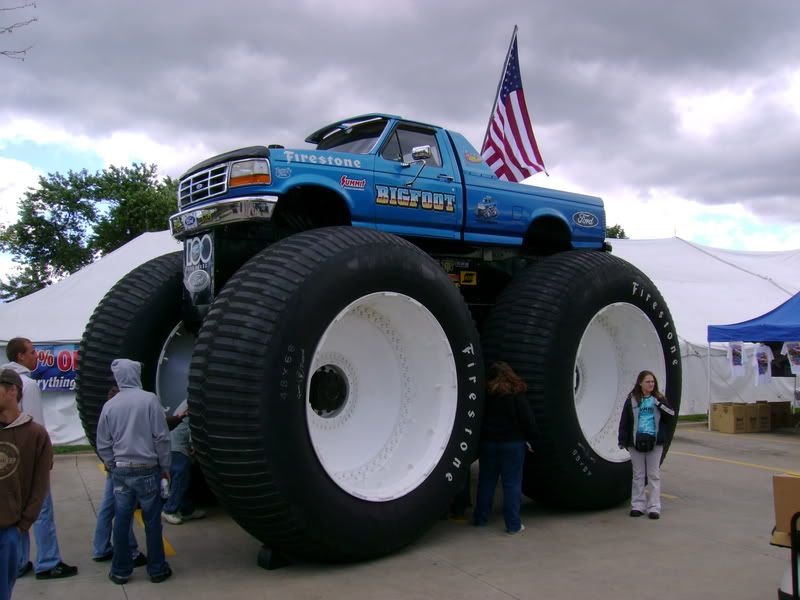
Sudden Impact is famous for its blue tires, made with a blue coloring instead of the regular black.
Brand new tires delivered to Sudden Impact Racing.
Bigfoot gets a flat tire.
El Toro Loco loses a tire in Arlington 2012. The lost tire in this photo bounced once and flew up over 20ft.
The same tire as in the previous picture bounces right over Fiesta.
Grave Digger loses a right-back tire, leaving only the rim.
Ragin Steel, crushing a parked Sting with a very damaged flat tire.
Basketball-styled BKT tires.
Max-D with BKT tires.
An Escalade's spinning rims (right).
Firestone Turf Tires
Advert for the Marcher W-10A tire featuring Rammunition
Advert for the Marcher QZ-702C tire featuring El Toro Loco
Typical monster truck tires
One of the most recognizable features of a monster truck are its large tires. Monster trucks use tires originally created for agricultural equipment, modified for use on monster trucks, with some tires being specifically made for monster trucks. Standard modern monster truck tires are 66 inches tall and 43 inches wide.
Standard modern monster truck tires are 66 inches tall and 43 inches wide.
With the growing popularity of mud bogging in the 1970's, there began a quest to find larger, more suitable tires for increasing a 4-wheel drive pickup truck's capabilities in the mud. Early on, 48 inch agricultural tires were the standard for the few monster trucks that did exist, such as Bigfoot and King Kong, specifically the iconic design of the Goodyear Super Terra Grip tires. These tires are also known as flotation tires, as they were originally designed so that their volume of air means the farming equipment that uses them can float slightly on wet, muddy fields instead of sinking into the mud and getting stuck.
In 1979, a vehicle known as "Mud Rat" was seen at a mud bogging event sporting a set of 66x43-25 inch Super Terra Grip tires, which caught the attention of various monster truck owners, giving them the inspiration to put them on their trucks as well. On September 1st, 1982, Bigfoot 2 would make its first public appearance with a set of 66 inch Terra tires, leading others to follow suit.
On September 1st, 1982, Bigfoot 2 would make its first public appearance with a set of 66 inch Terra tires, leading others to follow suit.
An example of just how far the tires flex for just a split second
One tire alone, without the rim, can weigh anywhere from 800-900lbs; when multiplied by four, tires take up about a third of the truck's average 10,000lb weight. A team can go through as many as eight tires in a single year. Tires can cost $2500-$7500 each. Despite their size and rigidity, due to the weight of the trucks the tires tend to flex a considerable amount. This generally occurs only for a split second, but sometimes the tires flex so much that the rims of the wheels make contact with the ground. To combat this, some drivers over-inflate the tires. This, however, raises the risk of tire blowouts.
A finely cut tire
One of the most distinct elements of a monster truck tire is the tread pattern of the tire. The agricultural tires that are the basis of monster truck tires usually have a simple tread of deep, sharp V-shaped or alternating stripes (depending on manufacturer) intended to provide grip in mud or loose soil without getting clogged with earth. For monster truck use, this tread is modified by the team, usually by removal of some rubber through "cutting". Tire cutting is done though for more than just stylistic reasons, though, as different tire treads result in different performance. Tire cutting is also done to accommodate the driver's driving skills and the conditions in which the truck will be driven. The most common modification made is to reduce the overall tread depth, which reduces weight and increases flexibility, and to round the edge of the tread near the sidewall, which makes it easier for drivers to upright the truck if they land on the edge of the tire after a jump. Cutting each individual tire takes approximately 50 consecutive hours.
The agricultural tires that are the basis of monster truck tires usually have a simple tread of deep, sharp V-shaped or alternating stripes (depending on manufacturer) intended to provide grip in mud or loose soil without getting clogged with earth. For monster truck use, this tread is modified by the team, usually by removal of some rubber through "cutting". Tire cutting is done though for more than just stylistic reasons, though, as different tire treads result in different performance. Tire cutting is also done to accommodate the driver's driving skills and the conditions in which the truck will be driven. The most common modification made is to reduce the overall tread depth, which reduces weight and increases flexibility, and to round the edge of the tread near the sidewall, which makes it easier for drivers to upright the truck if they land on the edge of the tire after a jump. Cutting each individual tire takes approximately 50 consecutive hours.
Obsessed runs its tires backwards.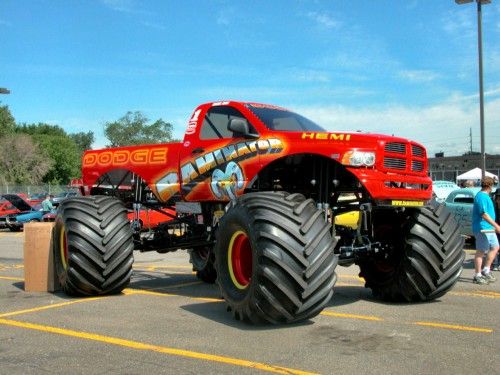
A majority of trucks have their tires mounted with the tire stripes pointing downwards. On occasion, trucks may run some, or all tires facing the opposite direction. This may be for stylistic reasons, or because the backwards facing tire is an opposite side replacement for a flat.
Tire types
There are plenty of tire designs and almost all trucks used a familiar ‘V’ tread pattern. It helps the truck maintain grip on dirt surfaces and even in mud races. There are some unique tread patterns that some trucks use for style.
• Common ‘V’ Tread: a tire that has a slanted ‘V’ tread that overlaps one another slightly. MOST trucks in shows, particularly Monster Jam would use these tires made by BKT.
• Hybrid Tread: this tire has a unique light V Tread that trucks would use for racing. These tires were seen and used on many trucks such as Bounty Hunter. These types are lesser known and are still used to this day.
• Half Striped: these tires as lesser known and were used on the monster trucks Predator, Prowler, and Pouncer.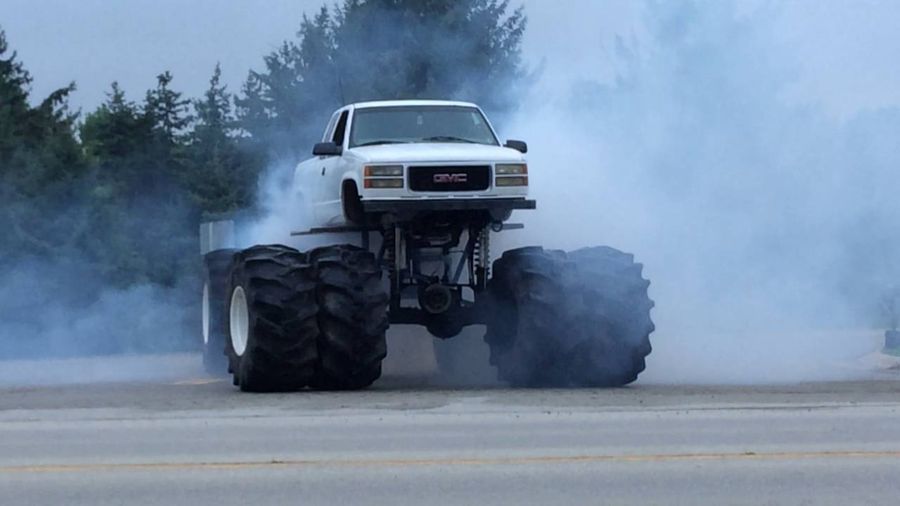 The treads are unique and they have more of spiked style edges to the tire to help the truck gain grip while turning tightly. These tires were originally made by Goodyear before they were discontinued.
The treads are unique and they have more of spiked style edges to the tire to help the truck gain grip while turning tightly. These tires were originally made by Goodyear before they were discontinued.
• Plain: tires that have NO tread, or have little grooves within. These tires are used on concrete surfaces or used on ride trucks. These tires are RARELY used on any competition trucks, but these tires HAVE been used before in trucks such as Prowler, Pouncer, Predator, and Avenger.
Bigfoot having been unloaded from its trailer.
Monster truck tires are so large with their regular tires that they cannot fit into their transportation trailers. Because of this, the tires have to be mounted on and unmounted back off after every show weekend. Much smaller tires, taken from the ones used for irrigation equipment, are put onto the truck so it can be driven back into its trailer. These are used as they can match the hubs on the large tires. Trailers have doors on the side that allow for the tires to go in and out easily when loading and unloading the truck.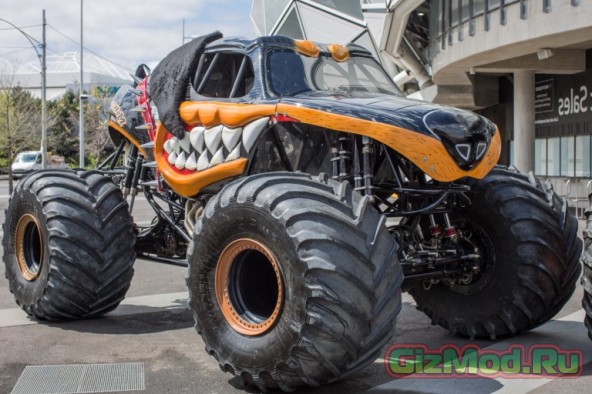
The most notable non-standard tire used are ten-foot tires: First used for monster trucks on Bigfoot 5, these were originally created for use on a US Army "land train" in Alaska. "Plain" tires are used mostly on ride trucks, and rarely on race trucks. The most notable exception was when Predator trucks exclusively used these tires in the early 2000's.
 )
)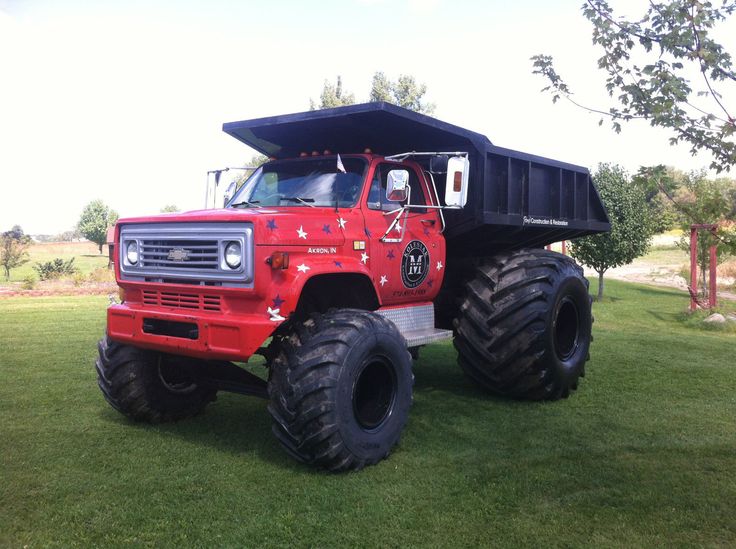 Due to its finer cut and sharper corners, the Ukraine Tires are more durable and can withstand a large amount of abuse.
Due to its finer cut and sharper corners, the Ukraine Tires are more durable and can withstand a large amount of abuse.Raging Bull loses a tire in 2015 that hit 9 people. Thankfully, nobody was killed.
Trucks can often times lose tires from hard hits, causing them to roll away over great distances. The large weight of the tire can pose a safety risk when this happens. In 2012, when Marc McDonald, driving El Toro Loco in Arlington Texas, lost a tire during freestyle, it bounced several times, initially in excess of 20+ feet high. It collided with the Fiesta truck and landed wedged between the truck and the wall; thankfully, nobody was hit by the tire. That was the second time that night a truck had lost a tire, a nearly similar incident happened with Bounty Hunter during that same show.
In 2015, Raging Bull lost a tire at a monster truck show and caused it to roll into a fence next to a section of spectators. The tire crashed into the fence and injured nine spectators on the other side; thankfully, nobody was killed.
In 1998, a fire burned down a garage resulting in Demon, Kimosabe, Showtime, and the Weapon 1 Ride Trucks all being destroyed. The fire was caused by tires that caught fire due to a faulty battery on a "power wheels" vehicle. The tires expanded from the heat until they violently burst, resulting in further explosions and causing the destruction of the garage.
Gas Monkey Monster Truck Tire Installation - Monster Jam
Video of tires being mounted on Gas Monkey Garage
Regular tires.
A chunkier, more rigid tire cut.
Tires with slanted lugs.
Firestone tire.
El Toro Loco's "Hybrid" tires.
Brute Force with "fine cut" tires.
Predator's "Half striped" tires.
Grave Digger 11 running "plain" tires.
Pouncer with two front "plain" tires, one of the very few times they have ever been used on a racing truck. Also, the back tires are backwards.
Dale Earnhardt, Jr. with "checkered" tires.
Two variants of the Scaly tire on Storm Damage.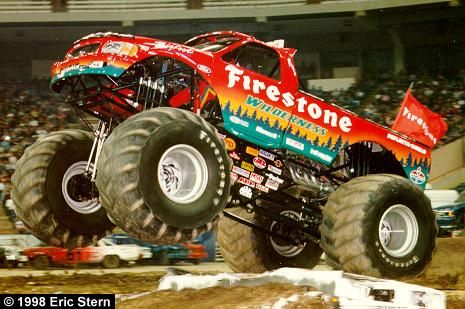
Gangsta, with 'overlapping" tires.
The Red Ford Grave Digger with tractor tires.
5 Ton Turd with smaller, mud bogging tires.
Bigfoot 5 with its notable 10 foot-tall tires.
Superfoot with a different variation of the 10-foot tires.
Grave Digger's brand new BKT tires with purple beadlocks.
A tire shop full of monster truck tires.
Sudden Impact is famous for its blue tires, made with a blue coloring instead of the regular black.
Brand new tires delivered to Sudden Impact Racing.
Bigfoot gets a flat tire.
El Toro Loco loses a tire in Arlington 2012. The lost tire in this photo bounced once and flew up over 20ft.
The same tire as in the previous picture bounces right over Fiesta.
Grave Digger loses a right-back tire, leaving only the rim.
Ragin Steel, crushing a parked Sting with a very damaged flat tire.
Basketball-styled BKT tires.
Max-D with BKT tires.
An Escalade's spinning rims (right).
Firestone Turf Tires
Advert for the Marcher W-10A tire featuring Rammunition
Advert for the Marcher QZ-702C tire featuring El Toro Loco
In one of the previous articles, we talked about how to properly dispose of car tires. This is indeed a very serious problem, because the number of discarded but not properly disposed of tires in Russia is measured in millions of tons. Another opportunity to reduce environmental damage is the retreading of used tires.
The idea of extending the life of car tires dates back to the last century. Always and at all times, zealous car owners wanted more resource from tires. The most widespread are two technologies - the replacement of the tread tape and the so-called recutting of the tread (regruving). Those who remember the times of the USSR are probably familiar with the latest technology - during the years of total shortage it was a popular way to extend the life of tires, including cars.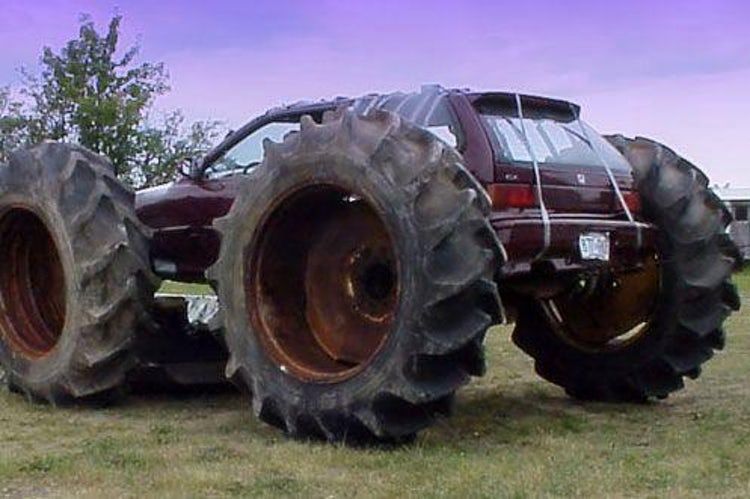 Of course, this happened with varying success - for example, retreaded tires could explode while driving due to the destruction of the cord.
Of course, this happened with varying success - for example, retreaded tires could explode while driving due to the destruction of the cord.
The second technology is the so-called welding, that is, the replacement of the tread tape with a new one, using a cold or hot method. Currently, this is the most popular method of tire retreading, which, however, has a number of limitations. Let's look at each technology in turn.
To begin with, the most important thing. Car tire carcasses are not designed to be reused, so they cannot be restored in any way! Everything that will be said about retreading applies only to "commercial" tires for trucks, construction equipment and buses. These tires have a strong all-metal carcass that can withstand much more than the tread, as well as a special design designed for two to three times recovery.
First, let's talk about regrooving the tread, or, as it is also called, regrowing.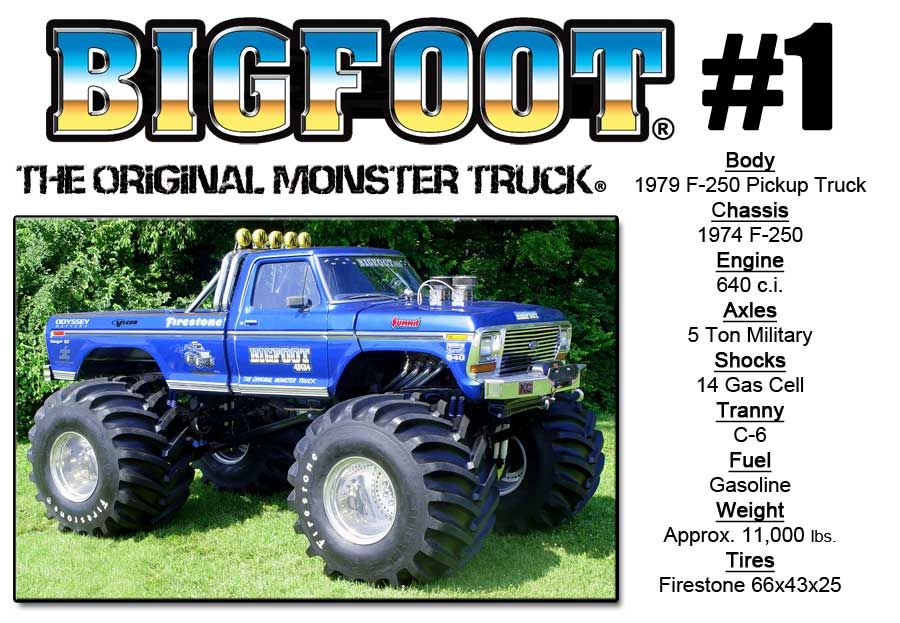 This is a procedure for deepening the tread with a hand-held cutting tool. Of course, this can not be done with any tires, but only with those that have the Regroovable marking.
This is a procedure for deepening the tread with a hand-held cutting tool. Of course, this can not be done with any tires, but only with those that have the Regroovable marking.
In such cases, the design of the tire implies an additional layer of rubber at the base of the tread, which allows you to deepen the pattern by about 3 millimeters, thereby “winning” another 35-40 thousand mileage. The optimal moment for recovery is tread wear up to 3 mm.
Image: Michelin
This retreading method is considered to be the most inexpensive - spending only 3-5% of the cost of a new tire on regrooving, you can get another 20-30% of the original resource.
Regrowing also has disadvantages. The success of the operation depends entirely on the quality of the framework and the skill of the specialist performing the recutting. Some tire brands allow multiple regrooving for certain models, but after that, the tread must still be replaced. In addition, in a number of countries, the installation of "undercut" tires on the front axles of buses is prohibited at the legislative level.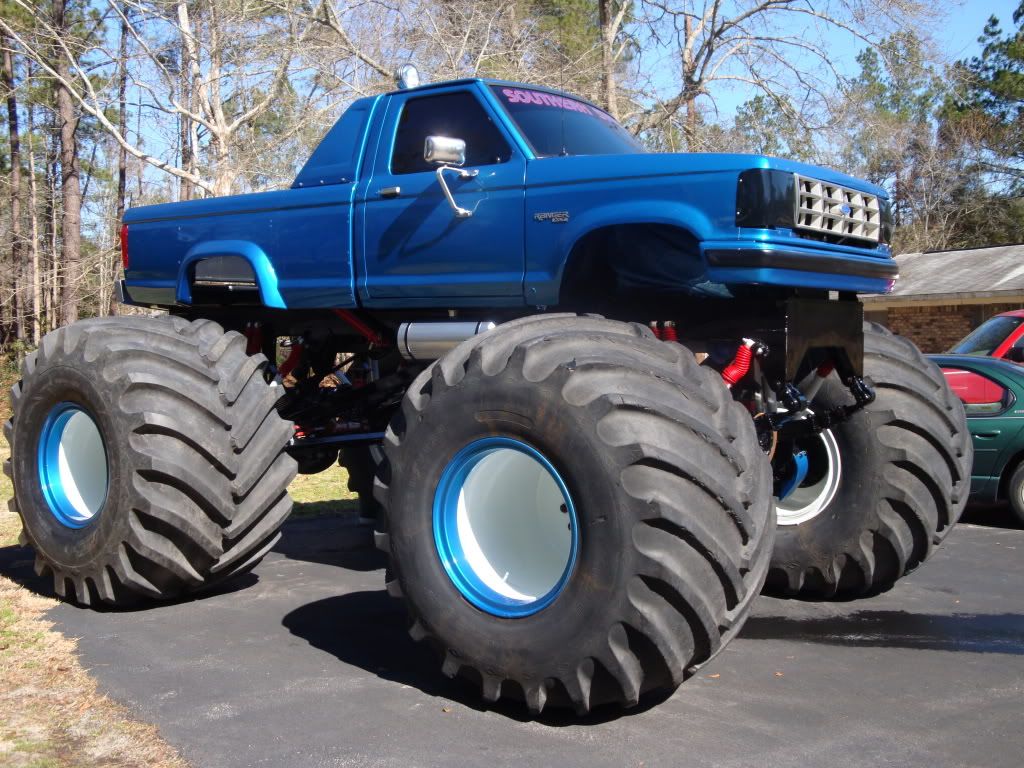
Retreading, or changing the tread band, is the most common way to retread truck tires, allowing them to recover at least 50-60% of their original life. Retreaded tires are widely used in all world markets, for example, in Europe they account for more than half of total sales.
Given the high quality of the tire carcass, welding can be performed repeatedly, increasing the tire life up to 450-500 thousand kilometers. Hardfacing can be cold or hot. Let's analyze the differences between these technologies.
When retreading car tires in small factories, the cold method is most often used.
Image: GoodYear
It looks like this. The worn tire is placed in a special machine, where the tread layer is removed from it with a cutter. The breaker layer is carefully inspected for defects, which are repaired using pneumatic tools. The next stage is extrusion, in which the breaker is covered with a layer of raw rubber covering all defects. After that - another layer of raw rubber.
After that - another layer of raw rubber.
Images: Nokian Tires
Next, the tread tape is applied to the tire. As a rule, all major tire manufacturers produce such tapes, for example, Nokian Tires calls such treads Noktop and E-Tread. An interesting feature of the Noktop tread is the two-layer structure. A softer top layer provides improved traction in winter. By spring, it wears off, revealing a more rigid tread, optimal for use at positive temperatures.
Image: Nokian Tires
The assembled tire is placed in a so-called envelope, from which the air is evacuated. Next, the tires are placed in an autoclave, where, at a pressure of about 4 atmospheres at a temperature of 110 degrees Celsius, the vulcanization process takes place. As a result, the tread is tightly connected to the tire carcass.
The second technology - hot vulcanization - is distinguished by the highest quality of recovery, but due to its high cost and energy consumption, it is used only in large-scale industries.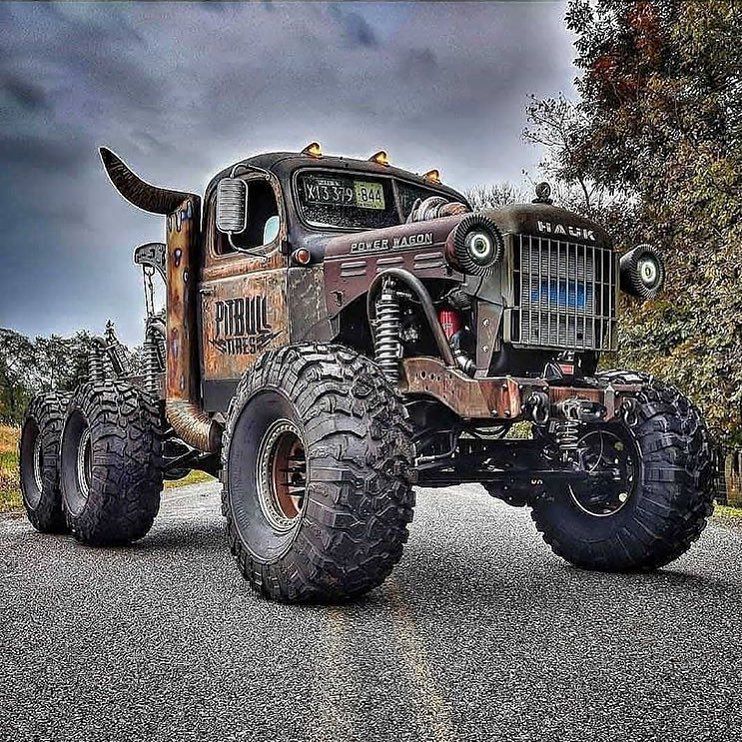
Hot welding is performed at 180 degrees Celsius and its main difference from the cold process is that a large layer of raw rubber (including sidewalls) is applied to the prepared carcass and then vulcanized with a press -shape on the tire is formed tread pattern - just like when creating a new tire.
For example, GoodYear has this technology called TreadMax or Next Tread. Technology means not only the tape itself, but also special equipment complete with technological maps.
Hot retread tires are more expensive than cold retread tyres, but their quality and service life are higher.
Modern technologies really make it possible to provide high-quality and even repeated retreading of truck and commercial car tires. But restoration is different for restoration - an artisanal procedure, performed in violation of technology, can lead to the separation of the tread tape and the destruction of the tire carcass while driving.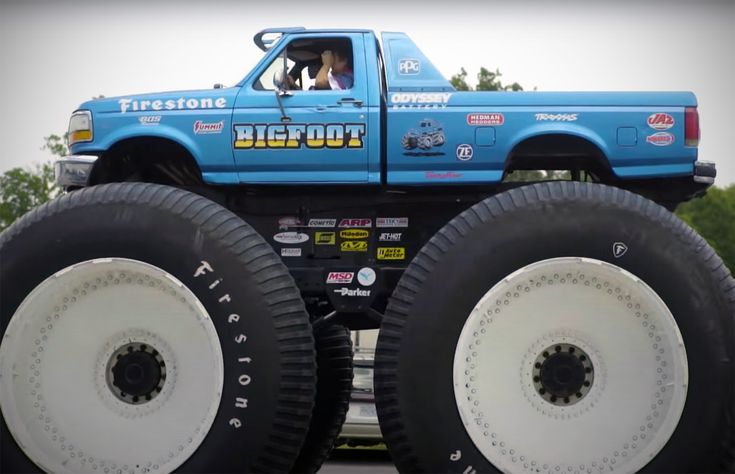
That's why, when choosing retreaded tires, contact only certified suppliers who work according to official factory technology and comply with all necessary quality standards. Buying “nameless” retread tires can be too expensive!
In difficult conditions for freight carriers, those who make every effort to reduce their costs survive. One of the ways to significantly reduce costs is the use of modern methods to extend the life of the wheel. In this article, we will look at two main methods aimed at increasing the mileage of a truck tire: cutting and retreading (welding) a truck tire.
Services Service Line:
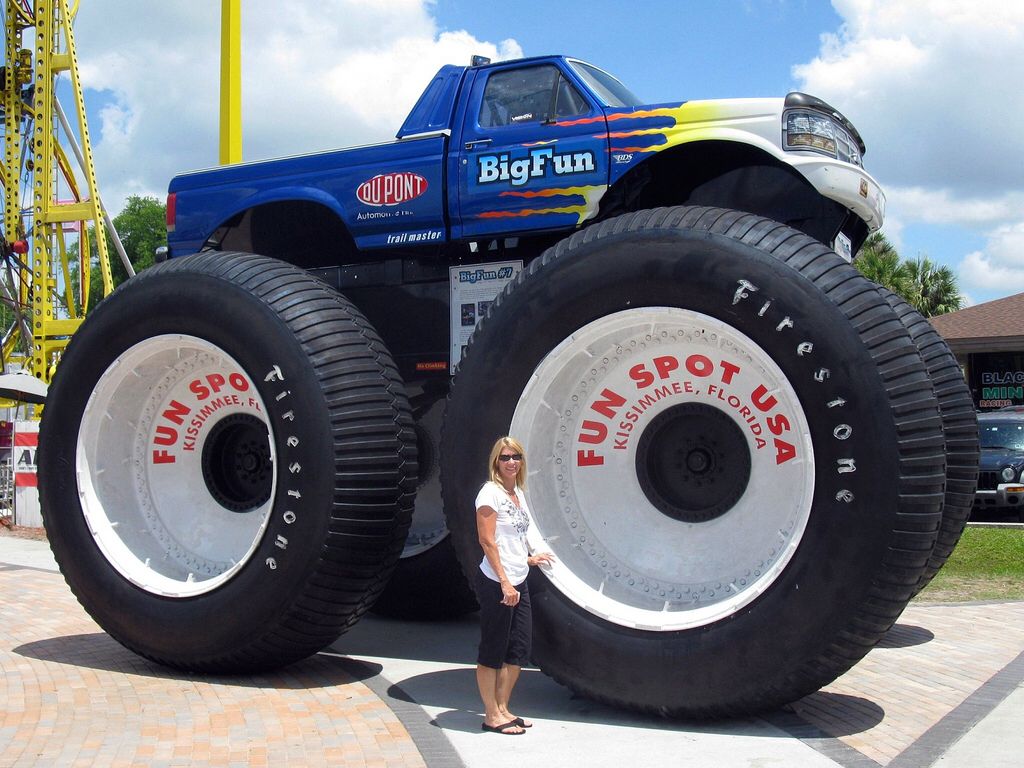
Unlike passenger tyres, manufacturers provide for regrooving for commercial tires, which is indicated by the REGROOVABLE marking on the sidewall of the tyre.
Deepening (cutting) of the tread pattern is made with a special tool (electrically heated knife) by cutting off part of the tread layer of rubber. The process is carried out according to the catalogs of tire manufacturers, which indicate the cutting parameters and the cutting pattern, which almost never repeats the previous one in all elements.
It is possible to cut technically sound tires that have:
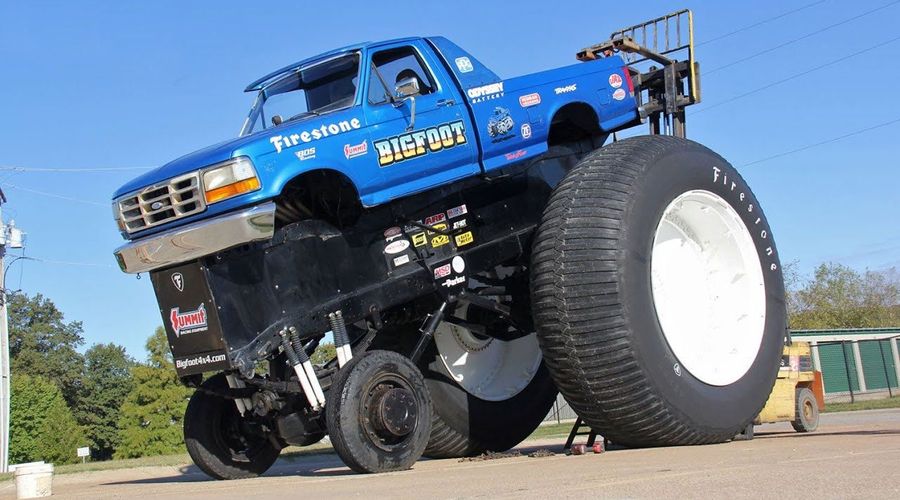 The fact is that cutting increases the tire mileage by a maximum of 50-80 thousand kilometers, and at a cost it is 4-7% of the cost of a new tire.
The fact is that cutting increases the tire mileage by a maximum of 50-80 thousand kilometers, and at a cost it is 4-7% of the cost of a new tire. But as the undertread layer becomes thinner when cutting, the tire becomes more vulnerable to damage. On our roads, this leads to the fact that the actual service life will increase by no more than 50 thousand kilometers. In this case, the tire carcass is in 90% of cases unsuitable for further use (restoration). Often, restorers are obviously reluctant to restore such tires, citing possible hidden defects.
Tire cutting, being a relatively inexpensive and quick way to increase tire mileage, is quite common. Truck tire slicing opponents fall into two categories. The former refuse cutting because of the warning about the deterioration of the characteristics of the truck tire after it. The latter, recognizing in principle the admissibility of tire cutting, do not use it due to the fact that many companies involved in cold retreading of tires do not accept cut tires for work.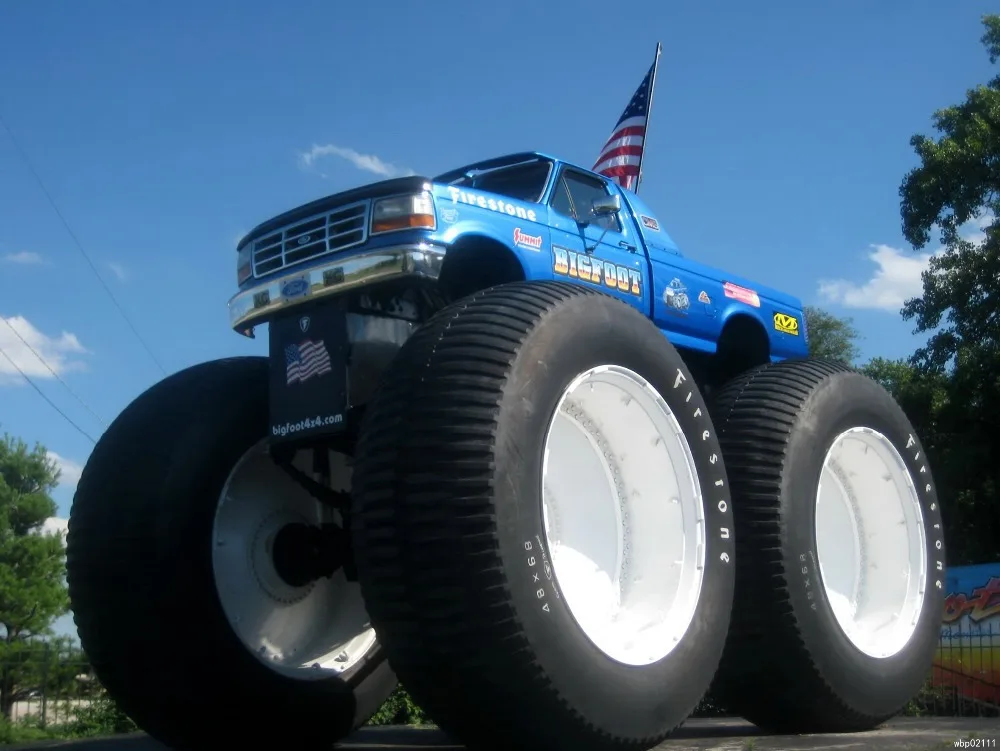 In fact, both arguments are based on one reason: the fear of low-quality cuts, and not cuts in general. Indeed, if even small sections of the tire breaker (colloquially speaking, cord) are exposed during cutting, the tire becomes unsuitable for further operation. If tires, for example, Michelin, are cut correctly and at least 2-3 mm are left from the level of the "bottom" of the deep tread of the tire to the upper breaker layer, then such tires are absolutely safe and suitable for both hot and cold retreading.
In fact, both arguments are based on one reason: the fear of low-quality cuts, and not cuts in general. Indeed, if even small sections of the tire breaker (colloquially speaking, cord) are exposed during cutting, the tire becomes unsuitable for further operation. If tires, for example, Michelin, are cut correctly and at least 2-3 mm are left from the level of the "bottom" of the deep tread of the tire to the upper breaker layer, then such tires are absolutely safe and suitable for both hot and cold retreading.
If for some reason there is no alternative to cutting, make sure that your service partner performs this operation strictly according to the tire manufacturer’s technological map - otherwise the performance of the cut tire may be critical do not comply with the operating conditions!
The only currently relevant and dominant document that establishes the standards for the use of tires in general and tires retreaded by cutting in the Russian Federation is the "Technical Regulations on the Safety of Wheeled Vehicles".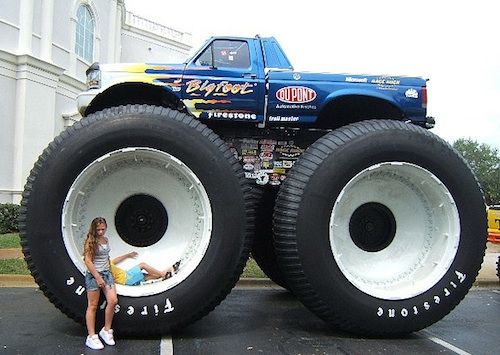 In Appendix No. 7 of this document there is a single phrase that defines the rules for the use of sliced tires. According to subparagraph 5.3.5, on tractor trucks, it is permissible to use sliced tires on driving and suspended axles (rear and middle), on trailers and semi-trailers - on all axles, on buses (and trolleybuses) - only on the rear, driving axles.
In Appendix No. 7 of this document there is a single phrase that defines the rules for the use of sliced tires. According to subparagraph 5.3.5, on tractor trucks, it is permissible to use sliced tires on driving and suspended axles (rear and middle), on trailers and semi-trailers - on all axles, on buses (and trolleybuses) - only on the rear, driving axles.
Professionals do not recommend using cut tires in winter.
Under Russian operating conditions, when working in contact with an aggressive environment (sand-salt mixture used as a de-icing agent), in the event of even minimal tire damage, the rate of cord destruction due to active corrosion increases sharply.
Still, the first step to increase mileage for an extremely worn high-end tire would be to retread it, as the carcass has a corresponding value and will provide extended tire life.
Tire retreading is a way to extend the service life of a truck tire by 2 or even 3 times by welding a new tread layer (band, ring) onto a worn tire.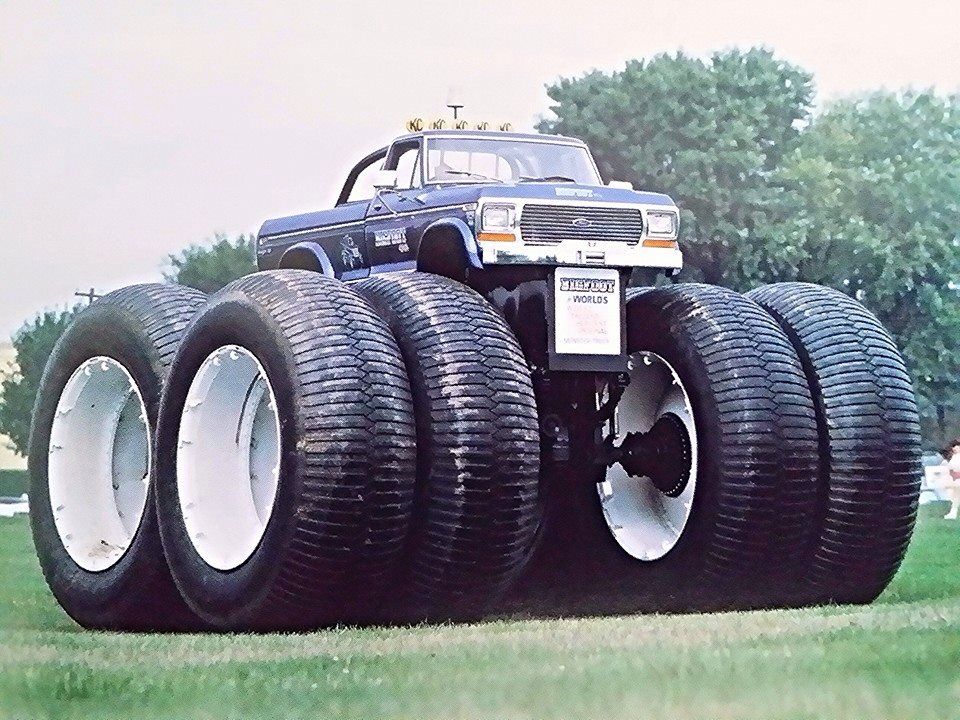
In Western Europe and the US, retreaded tires account for over 50 percent of the total truck tire market. According to statistics, 4/5 of the European companies providing transport services buy retreaded tires, and these are not the poorest companies. In China, 8 out of 10 suitable tires are retreaded, which is reasonable: 80 liters of crude oil are spent on the production of a new tire, and only 7 liters are spent on retreading the same one!
In Russia, no more than 10 percent of commercial tires are retreaded. Market potential - on the face.
Michelin is one of the pioneers in the retreaded truck tire market in Russia: a leader in technology, product quality and service.
Michelin Multilife is a real way to reduce operating costs by reusing truck tire carcasses. The effectiveness of using the Michelin Multilife model can be easily calculated using cost per kilometer (CPC) indicators.
Cost per kilometer (CPC)
Formula RPC = (Cost of a new Michelin tire + Cost of Michelin Retread)
vehicle. After the retreaded Michelin Retread tire is worn out, calculate the cost per kilometer using the formula above. And you will see that despite the initially high cost of the Michelin tire, the cost of 1 km is one of the lowest - of course, only when carrying out the above measures to extend its life. Used retreading technology - cold welding of truck tires. With this welding method, the temperature at which the vulcanization process takes place is much lower, which avoids the negative effect of temperature on the tire carcass. It is the cold welding method that is most often used in tire retreading. Another advantage of cold rubber reconditioning is that it can be done more than once.
